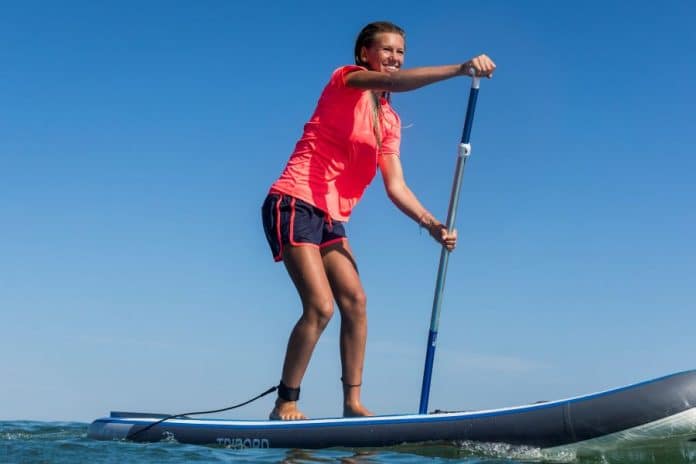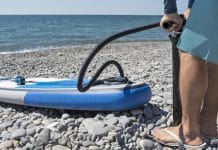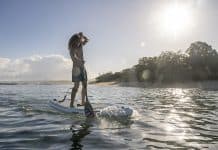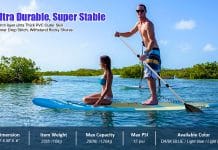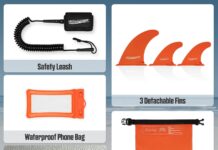If you’re new to SUPing, you’ll want to check out our guide on the basics of the sport.
This article will share some tips on gear, choosing a board, and riding.
Once you’ve read this guide, check out our other articles on SUPing in Sacramento!
Review contents
SUP Basics
You’ll want to keep a few things in mind when choosing SUP equipment. First, the dimensions of your board will play a significant role in your choice.
Most boards are around 36 inches wide by 18 inches long. Some are even a little wider or longer, so measuring your space and finding the right panel is essential.
Secondly, the SUP you’ll use will also affect the equipment you need. Paddle boards are the most common type and require SUP paddles.
Surfboards use fins to help them move through water, so they don’t require additional equipment.
Wakeboard boats use a different kind of paddle specifically designed for riding in water, so you’ll need to invest in those if you plan on using one.
Finally, consider your weight and height when choosing SUP gear.
Most boards are rated for up to 275 pounds, but heavier models are available if that’s more than you can handle.
Make sure to read the specifications carefully before making your purchase. And remember: never try to go beyond your board’s limits!
How to SUP
SUP stands for stand-up paddleboarding and is a great way to stay active while enjoying the water.
SUPing is not only a great workout but also a lot of fun! Here are some tips on how to SUP:
- Get comfortable with SUPing. Take some time to learn the basics before you hit the waves. The more you know, the easier it will be to have a great time!
- Choose the right gear. Make sure you have the right equipment for your environment and your skills. Wear sunscreen, sunglasses, and a life jacket if needed.
- Practice, practice, practice! Once you get the hang of it, SUPing can be exhilarating and rewarding. But don’t forget to enjoy the experience and take things easy first so as not to hurt yourself!
- SUPing is a great way to bond with your friends and enjoy a fun activity together! Don’t be afraid to ask for help. If you have questions or need some tips, don’t hesitate to ask someone else who knows more than you.
SUPing is a great way to stay active while enjoying the water. It’s not only a great workout, but it’s also a lot of fun! SUPing is a great way to bond with your friends and enjoy a fun activity together! Make sure you have the right gear for your environment and your skills, practice, and don’t be afraid to ask for help if you have questions.
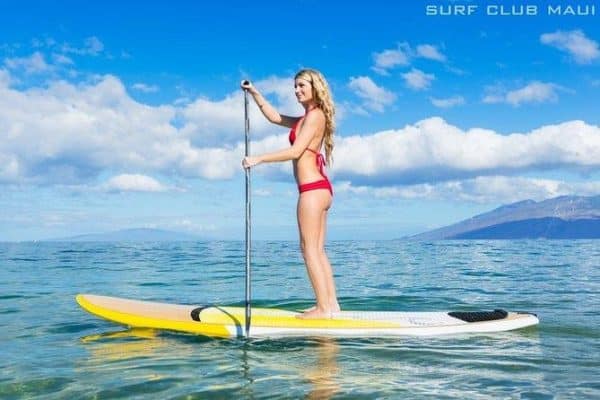
Read Next – Paddleboard Accessories: absolute must-haves
SUP Safety
SUP Safety is essential when paddling and using SUPs. Make sure to follow these tips to stay safe and comfortable while SUPing.
When paddling, watch your surroundings closely and be aware of local currents. If you see something that looks dangerous, avoid it! Stay in control of your SUP and use common sense when exploring new spots.
Always wear a life jacket if paddleboarding or SUPing in open water. Even if you feel comfortable in the water, wearing a life jacket will help protect you from unexpected falls or accidents.
Never ride without proper safety gear, including a leash for your dog if you’re taking them out on a paddleboard or SUP. And always check local regulations before hitting the water!
Read Next – 5 Life Jacket Tips That Will Save Your Life
SUP for Beginners
If you’re a beginner looking to buy your first SUP, here are some tips and gear to remember.
First, consider the type of board you want. A longboard is fantastic for beginner surfers because it’s forgiving and stable on the water.
A shortboard will be more challenging but fun if you want to take on waves.
Next, think about what kind of mounting system you’ll need.
Most boards have a fin/rocker configuration that attaches to the rider’s feet.
However, some riders prefer a quad-mounting system that attaches between the rider’s ankles and the board using straps.
Lastly, make sure you have the proper gear:
- A paddle
- A lifejacket
- Sunscreen
- A hat
- Sunglasses
- A water bottle
Read Next – The Importance of Dry Land Training for Standup Paddling
SUP Tips for All-Around Fun
SUP Tips for All-Around Fun
If you’re looking for SUP tips to get the most out of your paddling experience, check out the following list.
Whether you’re a beginner or an experienced SUP surfer, these tips will help you enjoy your time on the water even more!
- Get comfortable with your SUP – This is significant if you’re a beginner. Make sure to find a stable spot on the water and get used to paddling with and without the board. You’ll be able to control your movements better and have more fun!
- Know your SUP – The dimensions, weight limits, and types of SUPs available. There are inflatable boards, surfboards-on-a-watercraft, and standup paddleboards (SUPs). Knowing what type of board is best for you will help you make the most of your adventure.
- Practice, practice, practice – Even if you’re an experienced SUP surfer, there’s always room for improvement. Get in as many waves as possible and try different maneuvers while SUP surfing. You’ll quickly learn what feels comfortable and what works best for you.
- Bring some essential gear – Sunscreen, sunglasses, hat, and water shoes- all necessary for SUPing. And, of course, don’t forget your SUP!
- Explore – SUPing is all about getting out there and discovering new places. Bring along a map or GPS device to find new spots to paddle. Or head to one of the many coastal communities nationwide that offer great SUPing opportunities.
Read Next – Paddle Board Size Calculator: How to Find Your Perfect Size Board
SUP Tips
If you’re new to SUP or need a refresher, check out our beginner’s guide.
Here are some SUP tips to help you get the most out of your experience:
- Stand up when paddling: Keep your arms and legs moving. This will help conserve energy and increase speed.
- Extend your arms and legs: When paddling, start standing with your feet hip-width apart and extend your arms and legs forward. This will increase the surface area of your paddle for more power.
- Use a sweep: Use a sweep to turn around quickly. To do this, grab onto the paddle with one hand while sweeping the other arm horizontally.
- Stay balanced: Focus on remaining motionless while leaning into the water with your paddle tip.
- Be patient: Getting used to SUP can take some time, so don’t be discouraged if it takes some practice to get good at it.
- Know your limits: If you’re unsure about your ability to stay safe and balanced on the board, don’t exceed your board’s rated weight and dimensions.
- Stay hydrated: Drink plenty of water while SUPing to avoid dehydration.
- Watch for waves: When you see a wave, paddle towards it as quickly as possible.
Wear a life jacket, sunscreen, sunglasses, and a hat when SUPing. And don’t forget to bring your SUP, a paddle, and some essential SUP gear!
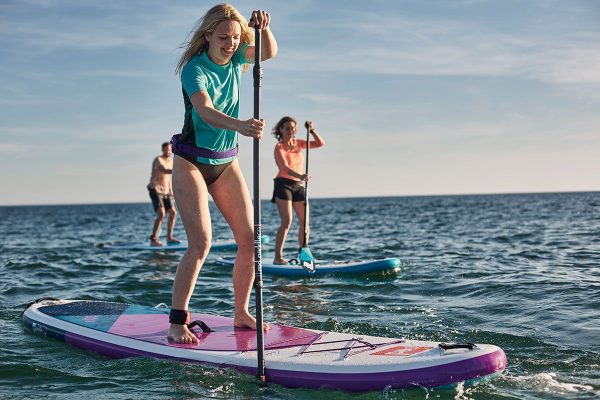
SUP Gear
Here are some of the best SUP tips to keep in mind when buying SUP gear:
- Know your body type. If you are a beginner, go for a smaller board; if you are an experienced paddler, go for a giant board.
- Consider what kind of water you will be using for your SUP. Flat water is perfect for beginner SUPers, while more experienced paddlers may prefer boards with more pop and stability on rougher water.
- Think about what features are important to you. For example, some people want a board that can hold lots of gear, while others want something simple to get started with.
- Be realistic about your budget. A good starter SUP can cost as little as $100, but higher-end models can cost upwards of $1,000. Make sure you have a budget before shopping.
- Finally, take into account your surroundings when deciding on SUP gear. For example, if you are using your SUP in urban areas with many obstacles like docks and bridges, make sure the gear you choose is durable and can handle a lot of abuse.
Read Next – Best Electric Pumps for Inflatable SUPs
How can I improve my SUP skills?
If you’re thinking about trying SUP but don’t know where to start, these SUP tips might help.
First, find a board that’s comfortable for you. Some people prefer shorter boards, while others prefer longer boards.
Once you’ve found the right board, get the size and shape of the SUP paddle.
The paddle should be long enough to cover at least two-thirds of your length on the board and wide enough to spread your hands evenly when paddling.
Finally, make sure to invest in some good SUP gear.
A quality hat, sunscreen, sunglasses, and a rescue whistle are all essential items to remember if you’re out in the water for an extended period.
Read Next – What Is SUP – Stand Up Paddling?
How do you stay balanced on SUP?
When paddle boarding or SUPing, it’s essential to stay balanced.
Here are some tips for keeping balance on SUP:
- Lean into the turns: When paddling or turning, lean into the turn rather than relying back on it. This will help you stay balanced and avoid tipping over.
- Stay aware of your surroundings: When paddling or turning, be mindful of your surroundings and what is around you. This will help you stay safe and avoid hitting anything.
- Use a paddle holder: If you’re not used to balancing on SUP, it can be helpful to use a paddle holder. These devices attach to your SUP and help you stay balanced while paddling or turning.
- Stay hydrated: Drink plenty of fluids to avoid becoming dehydrated. This can make it harder to stay balanced and lead to dizziness or other symptoms.
Read Next – Paddle Boards: Inflatable & Solid SUP Boards
What are the four golden rules of getting on your SUP?
- Stand up straight – This will put your center of gravity in the middle of your board, making it easier to balance and keep your balance while paddling.
- Keep your shoulders back – Pushing your shoulders down will cause you to lose balance and stability. Keep them pulled back so you can maintain control while paddling.
- Keep your hands close to the water’s surface – This will help you steer and stay on course. If your hands are far from the surface, controlling the board and staying on track will be harder.
- Use your legs – Your legs make you move on your SUP; use them to power through the water and push yourself forward.
These are the four main tips for getting on and off your SUP, but there are a few more specific instructions you should follow.
Paddle Boarding for Beginners: SUP Tips and Gear
When getting on your board, kneel and place your feet flat on the deck.
Next, slowly rise and place your hands on the railings, then push yourself up until you stand on the board.
Be careful not to touch the water with your hands or fists – this will cause you to lose balance and stability.
When getting off the board, proceed like getting on: kneel, place your feet flat on the deck, then push yourself up until you are standing on the board.
Once you’re standing, slowly lower yourself into the water until your feet are submerged.
Keep your hands close to the water’s surface while inching closer to the shoreline to avoid getting stranded if something goes wrong.
Read Next – How to Use A Paddleboard for Fishing
What is the trick to paddling boarding?
Paddle boarding is a unique and fun sport that anyone can enjoy. However, to get the most out of it, there are a few tricks that you need to know.
Here are five tips for paddle boarding that will help you have a great time:

